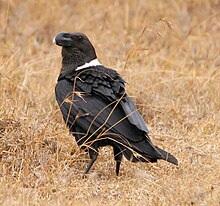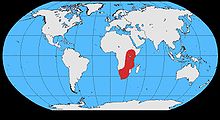White-necked raven
| White-necked Raven | |
|---|---|

| |
| Scientific classification | |
| Kingdom: | |
| Phylum: | |
| Class: | |
| Order: | |
| Family: | |
| Genus: | |
| Species: | C. albicollis
|
| Binomial name | |
| Corvus albicollis Latham, 1790
| |
The White-necked Raven, Corvus albicollis, is somewhat smaller (50–54 cm in length) than the Common Raven or indeed its nearest relative, the Thick-billed Raven C. crassirostris. It has a much shorter tail and a deeper bill with a white tip that is strongly arched (almost as much as the Thick-billed Raven). Though predominantly black, the throat, breast and neck are a blackish-brown in colour, with a faint purple gloss. There is a large patch of white feathers on the back of the lower neck.

It occurs in eastern and southern Africa in open, mountainous country. It is quite commonly found in small towns and villages as long as there are mountains or hills for roosting and nesting relatively near by.
Most of this birds food is obtained from the ground, but it will take food from trees also. It has been seen to drop a tortoise from a height on to hard ground, preferably on rocks, and then swoop down to eat it, or even pick it up again if not sufficiently broken. White-necked Ravens will also readily take carrion from road kills. Fruit, grain, insects, small reptiles, peanuts and human food are also readily taken and if not persecuted, will forage in back yards and gardens quite openly.
Nests are mainly on a cliff ledge but will occasionally nest in a tree. There are usually 3-5 eggs laid.
Often described as a raven with a sore throat, it has very similar calls to the Common Raven, but with a more husky note. It has a croak like the raven but with a more whispering note added.
Photo Image Links
Video links
- White-necked Raven videos, photos & sounds on the Internet Bird Collection
References
- ^ Template:IUCN2006 Database entry includes justification for why this species is of least concern

